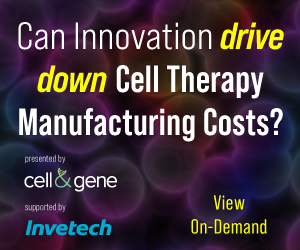Repurposing An Aging Facility To Produce Cell & Gene Therapies: Layout & Design Considerations
By Erich H. Bozenhardt and Herman F. Bozenhardt
As we noted in Part 1 of this two-part article, many life sciences companies are shifting their operations to encompass new life-saving cell and gene therapy products, also known as advanced therapy medicinal products. In many cases, this requires converting legacy manufacturing facilities to produce these new therapies. In this installment, we will look at the basic design aspects to consider when renovating a facility to meet the unique demands of these therapies without compromising quality.
new life-saving cell and gene therapy products, also known as advanced therapy medicinal products. In many cases, this requires converting legacy manufacturing facilities to produce these new therapies. In this installment, we will look at the basic design aspects to consider when renovating a facility to meet the unique demands of these therapies without compromising quality.
Modern cell therapy and biotech facilities have many basic requirements for continuous operation that need to be built into a robust facility. With future cell therapy and protein production, we are faced with small volumes, smaller working systems, higher value product, and potentially highly infectious materials.
The key consideration in any modern renovation is planning a space that accommodates the ICH/PICS guidelines, EU Annexes 1 and 2, and the FDA’s CFR 211. Due to the wide range of therapies, viral vectors, and bacterial organisms, the CDC’s guidelines for biosafety levels 1 and 2 (BL-1 and BL-2) and corresponding NIH design guides may also apply.
Ultimately, this leads us to a few basic concepts:
- Large open processing suites with ample room to move processing skids in and out, as well as isolator systems for various cell processing
- Space to stage volumes of disposables
- Unidirectional flow of all personnel, materials, equipment, production, and waste
- Segregation of all processing suites by air handling unit (AHU) to provide a robust facility
- AHU zoning to contain any contamination within the suites
- Air pressurization schemes in suites to contain BL-2 materials
Layout Considerations
What do we need to adapt to produce cell and gene therapies?
An important part of renovating a space for a new function is to step away from the existing layout and conduct a space planning exercise. Adjacency and transition bubble diagrams are effective tools for this. The bubble diagram allows us to better evaluate the existing space to determine what could be repurposed and what would comprise the design. It is an important step in defeating the temptation to just stick new equipment in an old space.
What does this new space for cell therapy look like?
Current processes are still working with a few operations that are open. These are typically at the start of the process, the end, and at media supplementation/vector addition. As products reach commercialization, these operations may be closed. When laying out the space, designs should consider both the current need and the potential future state. With the majority of the process closed, an open ballroom-type space can be utilized for most of the process. Smaller spaces (rooms or isolated environments) should be designated for the open operations. Close proximity of the supporting space to the main operation is needed for operations that process the start of the lot or the end. Isolators could allow the open operation to be in the ballroom suite. Isolator vendors have been listening to what is needed to support cell therapy and have developed solutions like rapid pass chamber cycles and improved dexterity gloves. Media/vector operations could be more distant if needed. Throwing a bunch of biosafety cabinets (BSCs) into a Grade B room is not a solution. The EMA guidance very strongly recommends developing a more robust solution.
One area that is critical to cell therapies but is lacking in most existing spaces is space for freezing the product or in-process material. The cell banking operation of a monoclonal anti-body (mAb) facility is too small and the blast freezing processes of vaccine plants are too large. It may be tempting to place this operation in the warehouse, but we must be aware of the processing time constraints and having the right personnel for the operation.
What does this new space for gene therapy look like?
Transitioning to viral vector/in-vivo gene therapy production can seem like a direct matchup to traditional biotech. Mammalian cell culture, chromatography, and tangential flow filtration are common to both mAbs and viral vectors. For viral vectors, the process train is almost exclusively single use, with production bioreactors topping out at 2,000 L, though for most in-vivo, it is in the 500 L to 1,000 L range and for ex-vivo, 250 L or smaller. Viral contamination is a major risk that can’t be mitigated with orthogonal virus reduction methods, so we have to think about protecting the operators and environment from the product. There isn’t a platform yet, and with acquisitions and process development, there isn’t long-term certainty of the process needs. Many times, these thoughts drive the seed train to be in one room and the production bioreactor to be in a room by itself or in a common downstream room.
Infrastructure (Then, Now, And Future)
The infrastructure requirements for viral vector/in-vivo gene therapy are similar to those of traditional biopharmaceuticals that utilize a single-use equipment train, but potentially at a smaller scale. Cell therapies have different infrastructure needs. Large water systems and process/biological waste drainage are gone. Small but highly distributive systems for air, carbon dioxide, and possibly oxygen are present. The one utility that will increase over traditional biopharmaceuticals is liquid nitrogen. Thinking beyond utilities as infrastructure, autologous cell therapies require a change in operations more like bespoke production. Managing this in a compliant and efficient way requires automation and manufacturing execution systems to be thought of as critical infrastructure.
HVAC
The HVAC design switches from product protection to product and environment containment. This drives us to look at having:
- one AHU per operating suite
- evaluating whether to add HEPA filters on the returns or if 100 percent once-through air is the better solution (We cannot contaminate the AHU if we ever expect to maintain it.)
- separate in/out airlocks
- building in unidirectional flow
The particular solution for containment segregation will ultimately have to match the risks associated with a particular process (e.g., BSL-1, BSL-2, airborne agent or not) and operational needs (e.g., multiproduct, how waste is handled). In one example, a multiproduct in-vivo gene therapy facility utilized a clean supply corridor and return corridor philosophy with bubble airlocks in and sinks out. The bubbles were on the corridor AHU, the sinks were fully exhausted, and each suite was recirculated through a dedicated AHU. This facility selectively used low leakage hermetically sealing doors at the boundary of the space served by an AHU to allow the AHU to be taken off-line and the room fumigated while operations continued in adjacent rooms.
A single-product autologous cell therapy facility used a mix of the containment airlock philosophy for rooms with open operations and traditional cascade out for rooms with closed operations.
Operational Considerations
An in-vivo gene therapy facility could require some new operational methods depending on what the site is familiar with, but the methodology is in use in other aspects of the industry. Cell therapies can lead to operational challenges that we as an industry are just starting to understand. How do you maintain chain of custody? This will drive how you segregate equipment and workspaces. How do you manage batch records for products where a batch is for one patient and may need to be released in hours or days instead of weeks? How is the staffing/shift schedule going to adapt to a scale-out type process?
Qualification
The first major challenge with qualification of a cell or gene therapy facility is that these projects are typically being fast tracked. Sometimes, that is with good reason, as we want to get a product that is demonstrating >90 percent survivability in relapsed cancer to patients quickly. In the rush, though, we can’t lose sight that the process needs to deliver products of a consistent quality. For viral vectors/in-vivo gene therapy, single-use systems and the similarity in scale to process development can lead to simple alignment of requirements if worked out with the vendor up front. Cell therapies run the full spectrum of easy to complex. A CAR T cell process could use standard off-the-shelf lab equipment, whereas a process that uses custom robotics (that require computer system validation) could spend more time in qualification than it took to upfit the production suite.
Summary
As the industry expands production in the fields of cell and gene therapies/advanced therapy medicinal products, adapting legacy facilities to these new fields will be a profound consideration. The ability to successfully execute the necessary changes will require a comprehensive understanding of the existing facility’s condition, which might be ripe for renovation already, and a plan to meet the unique demands of these new therapy types. The challenge will be adapting and engineering a legacy facility and including all the critical requirements while not compromising on quality.
About The Authors:
 Erich Bozenhardt, PE, is the process manager for IPS-Integrated Project Services’ process group in Raleigh, NC. He has 14 years of experience in the biotechnology and aseptic processing business and has led several biological manufacturing projects, including cell therapies, mammalian cell culture, and novel delivery systems. He has a B.S. in chemical engineering and an MBA, both from the University of Delaware.
Erich Bozenhardt, PE, is the process manager for IPS-Integrated Project Services’ process group in Raleigh, NC. He has 14 years of experience in the biotechnology and aseptic processing business and has led several biological manufacturing projects, including cell therapies, mammalian cell culture, and novel delivery systems. He has a B.S. in chemical engineering and an MBA, both from the University of Delaware.
 Herman Bozenhardt has 44 years of experience in pharmaceutical, biotechnology, and medical device manufacturing, engineering, and compliance. He is a recognized expert in the area of aseptic filling facilities and systems and has extensive experience in the manufacture of therapeutic biologicals and vaccines. His current consulting work focuses on the areas of aseptic systems, biological manufacturing, and automation/computer systems. He has a B.S. in chemical engineering and an M.S. in system engineering, both from the Polytechnic Institute of Brooklyn.
Herman Bozenhardt has 44 years of experience in pharmaceutical, biotechnology, and medical device manufacturing, engineering, and compliance. He is a recognized expert in the area of aseptic filling facilities and systems and has extensive experience in the manufacture of therapeutic biologicals and vaccines. His current consulting work focuses on the areas of aseptic systems, biological manufacturing, and automation/computer systems. He has a B.S. in chemical engineering and an M.S. in system engineering, both from the Polytechnic Institute of Brooklyn.
Image courtesy of IPS


